Generating Large Time–Bandwidth Product RF-Chirped Waveforms Using Vernier Dual-Optical Frequency Combs
Abstract
1. Introduction
2. Concept and Theory
3. Results
3.1. Chirp Rate and Frequency Step
3.2. Time–Bandwidth Product
- The optical pulse width is smaller than the round-trip time .
- The RF chirp bandwidth is smaller than 300 GHz .
- The shot-to-shot frequency step is less than 100 GHz .
- The chirp rate is greater than KHz/ms and smaller than THz/ms.
3.3. Effects of the OFC’s Instabilities
4. Discussion
5. Conclusions
Funding
Data Availability Statement
Conflicts of Interest
Abbreviations
| OFC | Optical frequency combs |
| FTM | Frequency-to-time mapping |
| TBWP | Time–bandwidth product |
| VCO | Voltage-controlled oscillator |
| CW | Continuous-wave |
References
- Ma, C.; Wang, X.; Ding, Z.; Zhang, Z.; Pan, S. High-Resolution Microwave Photonic Sparse Imaging Radar. IEEE Trans. Microw. Theory Tech. 2025. [Google Scholar] [CrossRef]
- Ghelfi, P.; Laghezza, F.; Scotti, F.; Onori, D.; Bogoni, A. Photonics for radars operating on multiple coherent bands. J. Light. Technol. 2016, 34, 500–507. [Google Scholar] [CrossRef]
- Skolnik, M.I. Radar Handbook, 3rd ed.; McGraw-Hill Education: New York, NY, USA, 2008. [Google Scholar]
- Chan, Y.K.; Lim, S.Y. Synthetic aperture radar (SAR) signal generation. Prog. Electromagn. Res. B 2008, 1, 269–290. [Google Scholar] [CrossRef]
- Deng, H.; Zhang, J.; Chen, X.; Yao, J. Photonic generation of a phase-coded chirp microwave waveform with increased TBWP. IEEE Photonics Technol. Lett. 2017, 29, 1420–1423. [Google Scholar] [CrossRef]
- Alshaykh, M.S.; Xuan, Y.; Leaird, D.E.; McKinney, J.D.; Qi, M.; Weiner, A.M. Kerr combs for stimulated Brillouin scattering mitigation in long-haul analog optical links. J. Light. Technol. 2019, 37, 5773–5779. [Google Scholar] [CrossRef]
- McKinney, J.D.; Urick, V.J.; Briguglio, J. Optical comb sources for high dynamic-range single-span long-haul analog optical links. IEEE Trans. Microw. Theory Tech. 2011, 59, 3249–3257. [Google Scholar] [CrossRef]
- Kim, H.J.; Leaird, D.E.; Weiner, A.M. Rapidly tunable dual-comb RF photonic filter for ultrabroadband RF spread spectrum applications. IEEE Trans. Microw. Theory Tech. 2016, 64, 3351–3362. [Google Scholar] [CrossRef]
- Supradeepa, V.; Long, C.M.; Wu, R.; Ferdous, F.; Hamidi, E.; Leaird, D.E.; Weiner, A.M. Comb-based radiofrequency photonic filters with rapid tunability and high selectivity. Nat. Photonics 2012, 6, 186–194. [Google Scholar] [CrossRef]
- Xue, X.; Xuan, Y.; Bao, C.; Li, S.; Zheng, X.; Zhou, B.; Qi, M.; Weiner, A.M. Microcomb-based true-time-delay network for microwave beamforming with arbitrary beam pattern control. J. Light. Technol. 2018, 36, 2312–2321. [Google Scholar] [CrossRef]
- Kim, J.; Park, M.J.; Perrott, M.H.; Kärtner, F.X. Photonic subsampling analog-to-digital conversion of microwave signals at 40-GHz with higher than 7-ENOB resolution. Opt. Express 2008, 16, 16509–16515. [Google Scholar] [CrossRef]
- Harmon, S.R.; McKinney, J.D. Broadband RF disambiguation in subsampled analog optical links via intentionally-introduced sampling jitter. Opt. Express 2014, 22, 23928–23937. [Google Scholar] [CrossRef]
- Alshaykh, M.S.; Leaird, D.E.; McKinney, J.D.; Weiner, A.M. Rapid wideband RF subsampling and disambiguation using dual combs. In Proceedings of the CLEO: Science and Innovations, San Jose, CA, USA, 5–10 May 2019; Optical Society of America: Orlando, FL, USA, 2019; pp. 1–2. [Google Scholar]
- Wiberg, A.; Esman, D.; Liu, L.; Adleman, J.; Zlatanovic, S.; Ataie, V.; Myslivets, E.; Kuo, B.P.P.; Alic, N.; Jacobs, E.; et al. Coherent filterless wideband microwave/millimeter-wave channelizer based on broadband parametric mixers. J. Light. Technol. 2014, 32, 3609–3617. [Google Scholar] [CrossRef]
- Ataie, V.; Esman, D.; Kuo, B.P.; Alic, N.; Radic, S. Subnoise detection of a fast random event. Science 2015, 350, 1343–1346. [Google Scholar] [CrossRef] [PubMed]
- Ridgway, R.W.; Nippa, D.W. Generation and modulation of a 94-GHz signal using electrooptic modulators. IEEE Photonics Technol. Lett. 2008, 20, 653–655. [Google Scholar] [CrossRef]
- Lundberg, L.; Mazur, M.; Mirani, A.; Foo, B.; Schröder, J.; Torres-Company, V.; Karlsson, M.; Andrekson, P.A. Phase-coherent lightwave communications with frequency combs. Nat. Commun. 2020, 11, 201. [Google Scholar] [CrossRef]
- Pillet, G.; Morvan, L.; Brunel, M.; Bretenaker, F.; Dolfi, D.; Vallet, M.; Huignard, J.P.; Le Floch, A. Dual-frequency laser at 1.5 μm for optical distribution and generation of high-purity microwave signals. J. Light. Technol. 2008, 26, 2764–2773. [Google Scholar] [CrossRef]
- Li, J.; Lee, H.; Vahala, K.J. Microwave synthesizer using an on-chip Brillouin oscillator. Nat. Commun. 2013, 4, 2097. [Google Scholar] [CrossRef] [PubMed]
- Maleki, L. The optoelectronic oscillator. Nat. Photonics 2011, 5, 728–730. [Google Scholar] [CrossRef]
- Chembo, Y.K.; Brunner, D.; Jacquot, M.; Larger, L. Optoelectronic oscillators with time-delayed feedback. Rev. Mod. Phys. 2019, 91, 035006. [Google Scholar] [CrossRef]
- Li, J.; Yi, X.; Lee, H.; Diddams, S.A.; Vahala, K.J. Electro-optical frequency division and stable microwave synthesis. Science 2014, 345, 309–313. [Google Scholar] [CrossRef]
- Xie, X.; Bouchand, R.; Nicolodi, D.; Giunta, M.; Hänsel, W.; Lezius, M.; Joshi, A.; Datta, S.; Alexandre, C.; Lours, M.; et al. Photonic microwave signals with zeptosecond-level absolute timing noise. Nat. Photonics 2017, 11, 44–47. [Google Scholar] [CrossRef]
- Wu, K.; O’Malley, N.P.; Fatema, S.; Wang, C.; Girardi, M.; Alshaykh, M.S.; Ye, Z.; Leaird, D.E.; Qi, M.; Torres-Company, V.; et al. Vernier microcombs for high-frequency carrier envelope offset and repetition rate detection. Optica 2023, 10, 626–633. [Google Scholar] [CrossRef]
- Wu, K.; O’Malley, N.P.; Fatema, S.; Wang, C.; Girardi, M.; Alshaykh, M.S.; Ye, Z.; Leaird, D.E.; Qi, M.; Torres-Company, V.; et al. Vernier microcombs for integrated optical atomic clocks. Nat. Photonics 2025, 19, 400–406. [Google Scholar] [CrossRef]
- Huang, C.B.; Jiang, Z.; Leaird, D.; Caraquitena, J.; Weiner, A. Spectral line-by-line shaping for optical and microwave arbitrary waveform generations. Laser Photonics Rev. 2008, 2, 227–248. [Google Scholar] [CrossRef]
- Alshaykh, M.S.; Liao, C.S.; Sandoval, O.E.; Gitzinger, G.; Forget, N.; Leaird, D.E.; Cheng, J.X.; Weiner, A.M. High-speed stimulated hyperspectral Raman imaging using rapid acousto-optic delay lines. Opt. Lett. 2017, 42, 1548–1551. [Google Scholar] [CrossRef]
- Huang, C.B.; Leaird, D.E.; Weiner, A.M. Time-multiplexed photonically enabled radio-frequency arbitrary waveform generation with 100 ps transitions. Opt. Lett. 2007, 32, 3242–3244. [Google Scholar] [CrossRef]
- Huang, C.B.; Weiner, A.M. Analysis of time-multiplexed optical line-by-line pulse shaping: Application for radio-frequency and microwave photonics. Opt. Express 2010, 18, 9366–9377. [Google Scholar] [CrossRef]
- Torres-Company, V.; Weiner, A.M. Optical frequency comb technology for ultra-broadband radio-frequency photonics. Laser Photonics Rev. 2014, 8, 368–393. [Google Scholar] [CrossRef]
- Torres-Company, V.; Metcalf, A.J.; Leaird, D.E.; Weiner, A.M. Multichannel radio-frequency arbitrary waveform generation based on multiwavelength comb switching and 2-D line-by-line pulse shaping. IEEE Photonics Technol. Lett. 2012, 24, 891–893. [Google Scholar] [CrossRef]
- Chou, J.; Han, Y.; Jalali, B. Adaptive RF-photonic arbitrary waveform generator. IEEE Photonics Technol. Lett. 2003, 15, 581–583. [Google Scholar] [CrossRef]
- Lin, I.S.; McKinney, J.D.; Weiner, A.M. Photonic synthesis of broadband microwave arbitrary waveforms applicable to ultra-wideband communication. IEEE Microw. Wirel. Components Lett. 2005, 15, 226–228. [Google Scholar] [CrossRef]
- Torres-Company, V.; Leaird, D.E.; Weiner, A.M. Dispersion requirements in coherent frequency-to-time mapping. Opt. Express 2011, 19, 24718–24729. [Google Scholar]
- Dezfooliyan, A.; Weiner, A.M. Photonic synthesis of high fidelity microwave arbitrary waveforms using near field frequency to time mapping. Opt. Express 2013, 21, 22974–22987. [Google Scholar] [CrossRef]
- Li, Y.; Rashidinejad, A.; Wun, J.M.; Leaird, D.E.; Shi, J.W.; Weiner, A.M. Photonic generation of W-band arbitrary waveforms with high time-bandwidth products enabling 3.9 mm range resolution. Optica 2014, 1, 446–454. [Google Scholar] [CrossRef]
- Dezfooliyan, A.; Weiner, A.M. Microwave photonics for space–time compression of ultrabroadband signals through multipath wireless channels. Opt. Lett. 2013, 38, 4946–4949. [Google Scholar] [CrossRef] [PubMed]
- Tong, Y.; Han, D.; Cheng, R.; Liu, Z.; Xie, W.; Qin, J.; Dong, Y. Photonics-based coherent wideband linear frequency modulation pulsed signal generation. Opt. Lett. 2018, 43, 1023–1026. [Google Scholar] [CrossRef] [PubMed]
- de Chatellus, H.G.; Cortés, L.R.; Schnébelin, C.; Burla, M.; Azaña, J. Reconfigurable photonic generation of broadband chirped waveforms using a single CW laser and low-frequency electronics. Nat. Commun. 2018, 9, 2438. [Google Scholar] [CrossRef]
- Nakajima, Y.; Inaba, H.; Hosaka, K.; Minoshima, K.; Onae, A.; Yasuda, M.; Kohno, T.; Kawato, S.; Kobayashi, T.; Katsuyama, T.; et al. A multi-branch, fiber-based frequency comb with millihertz-level relative linewidths using an intra-cavity electro-optic modulator. Opt. Express 2010, 18, 1667–1676. [Google Scholar] [CrossRef]
- Rolland, A.; Li, P.; Kuse, N.; Jiang, J.; Cassinerio, M.; Langrock, C.; Fermann, M.E. Ultra-broadband dual-branch optical frequency comb with 10- 18 instability. Optica 2018, 5, 1070–1077. [Google Scholar] [CrossRef]
- Zhao, X.; Li, T.; Liu, Y.; Li, Q.; Zheng, Z. Polarization-multiplexed, dual-comb all-fiber mode-locked laser. Photonics Res. 2018, 6, 853–857. [Google Scholar] [CrossRef]
- Liu, Y.; Zhang, Z.; Burla, M.; Eggleton, B.J. 11-GHz-Bandwidth Photonic Radar using MHz Electronics. Laser Photonics Rev. 2022, 16, 2100549. [Google Scholar] [CrossRef]
- Tong, Y.; Zhou, Q.; Han, D.; Li, B.; Xie, W.; Liu, Z.; Qin, J.; Wang, X.; Dong, Y.; Hu, W. Photonic generation of phase-stable and wideband chirped microwave signals based on phase-locked dual optical frequency combs. Opt. Lett. 2016, 41, 3787–3790. [Google Scholar] [CrossRef] [PubMed]
- Tang, J.; Zhu, B.; Zhang, W.; Li, M.; Pan, S.; Yao, J. Hybrid Fourier-domain mode-locked laser for ultra-wideband linearly chirped microwave waveform generation. Nat. Commun. 2020, 11, 3814. [Google Scholar] [CrossRef] [PubMed]
- Fan, Z.; Li, X.; Su, J.; Wang, Y.; Shi, S.; Qiu, Q. Photonic-assisted programmable ultra-wideband frequency-modulated continuous-wave generator. J. Light. Technol. 2024, 42, 69–79. [Google Scholar] [CrossRef]
- Dong, X.; Wang, S.; Shi, M.; Li, B.; Chen, L.; Zhang, C.; Wong, K.K. Dispersion Engineering for Advanced Temporal Imaging Modalities. J. Light. Technol. 2023, 41, 4271–4282. [Google Scholar] [CrossRef]
- Chen, L.; Dong, X.; Yang, N.; Zhang, L.; Lei, Z.; Zhang, C.; Zhang, X. Pure temporal dispersion for aberration free ultrafast time-stretch applications. J. Light. Technol. 2021, 39, 5589–5597. [Google Scholar] [CrossRef]
- Serahati, Z.; Temprana, E.; Myslivets, E.; Ataie, V.; Alic, N.; Radic, S. Demonstration of a sub-ghz flat-top comb-based rf-photonic filter enabled by fourth-order dispersion compensation. J. Light. Technol. 2019, 38, 1194–1201. [Google Scholar] [CrossRef]
- Jamali Mahabadi, S.E.; Carruthers, T.F.; Menyuk, C.R.; McKinney, J.D.; Williams, K.J. Comparison of the impact of nonlinearity in ap-i-n and an MUTC photodetector on electro-optic frequency combs. Opt. Lett. 2021, 46, 813–816. [Google Scholar] [CrossRef]
- Caldwell, E.D.; Sinclair, L.C.; Newbury, N.R.; Deschenes, J.D. The time-programmable frequency comb and its use in quantum-limited ranging. Nature 2022, 610, 667–673. [Google Scholar] [CrossRef]
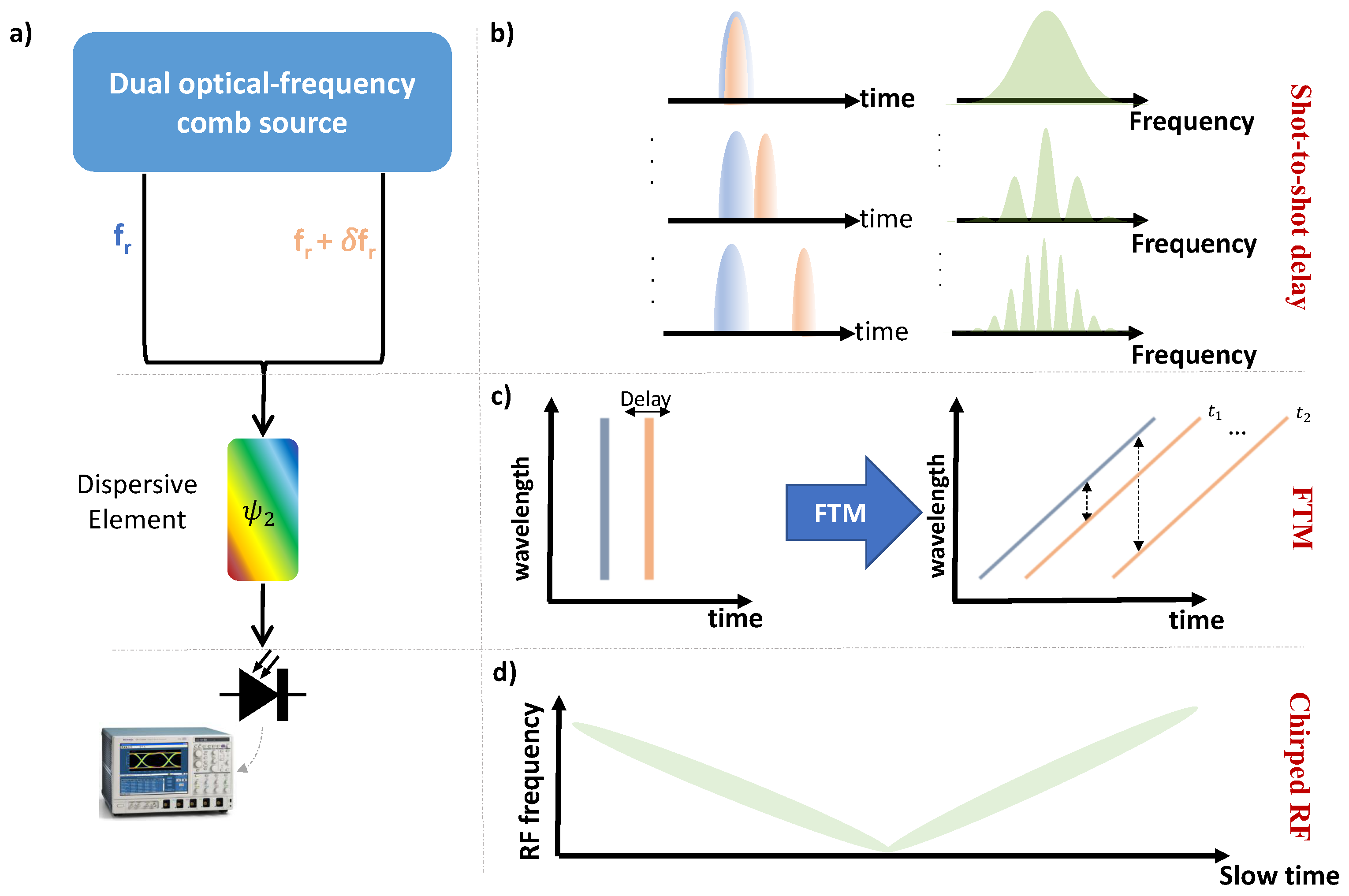
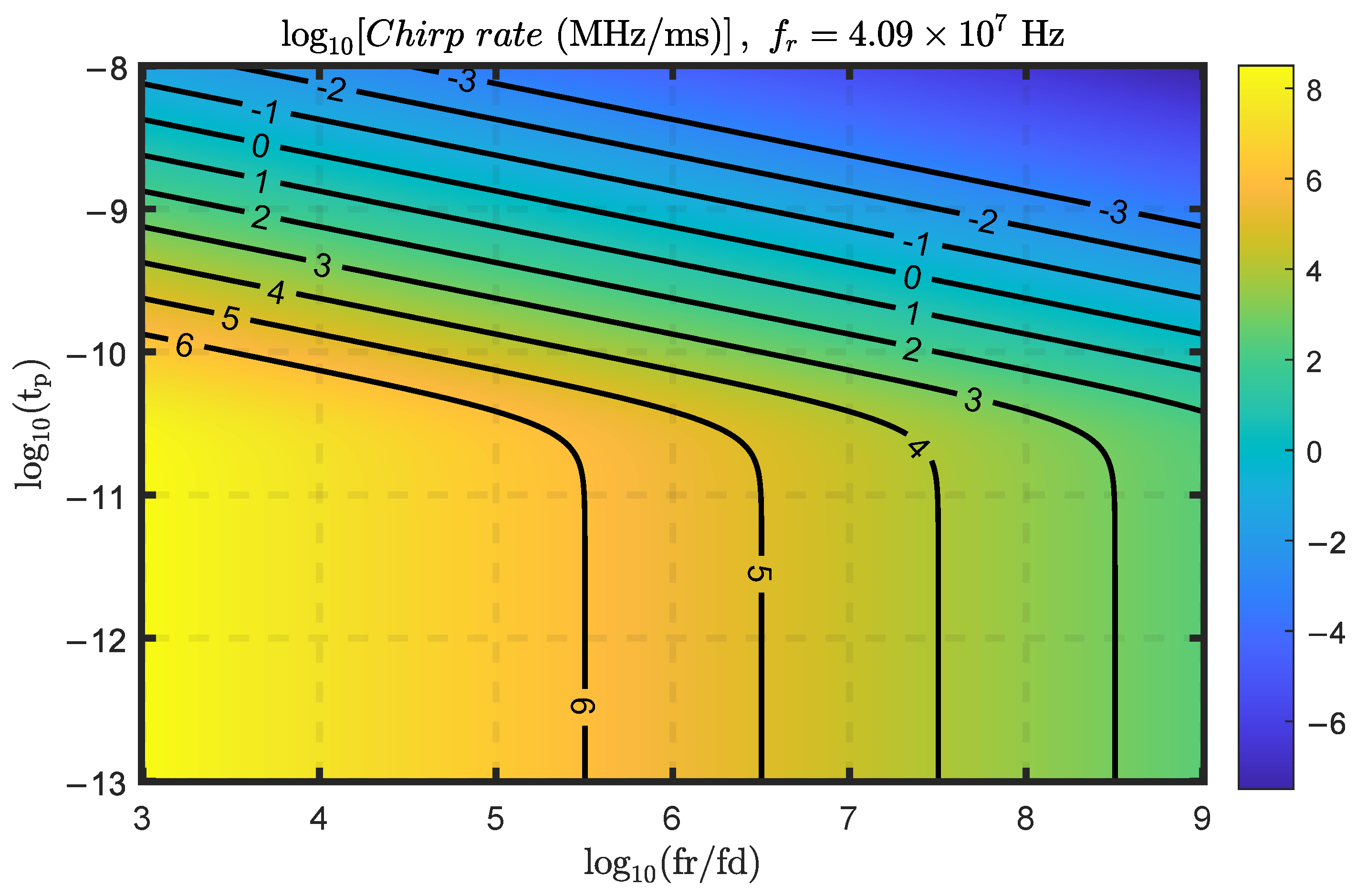
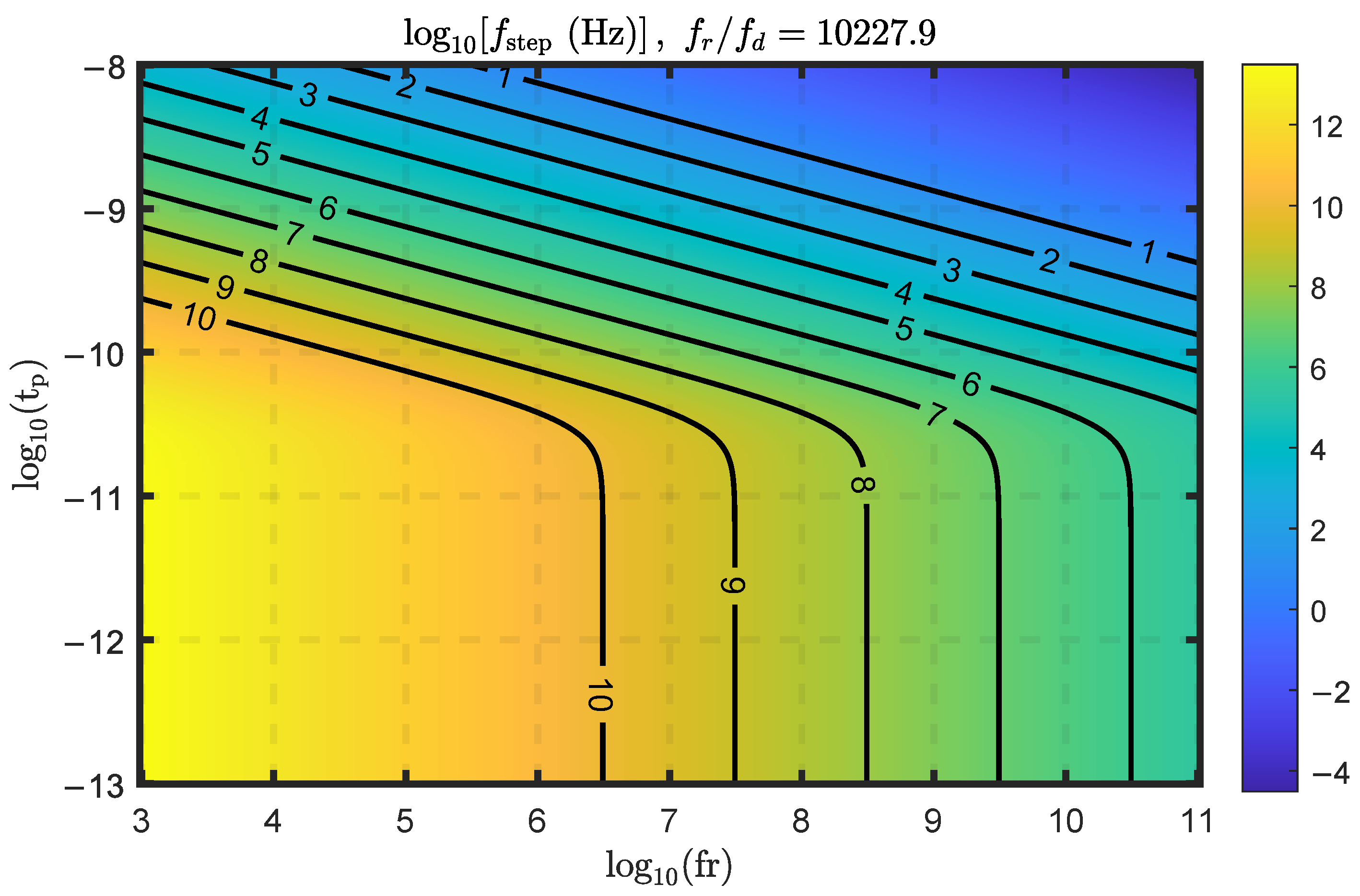
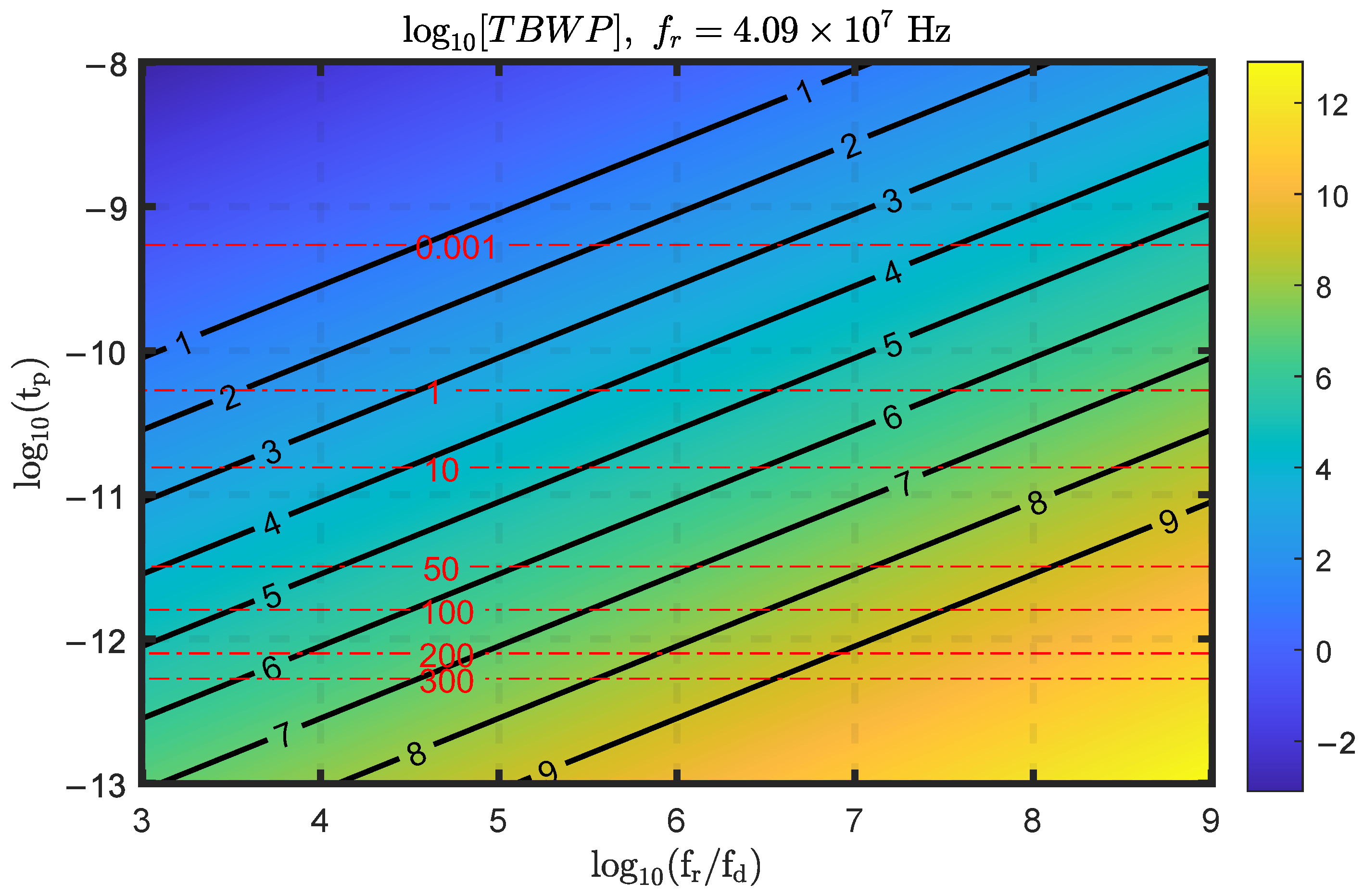
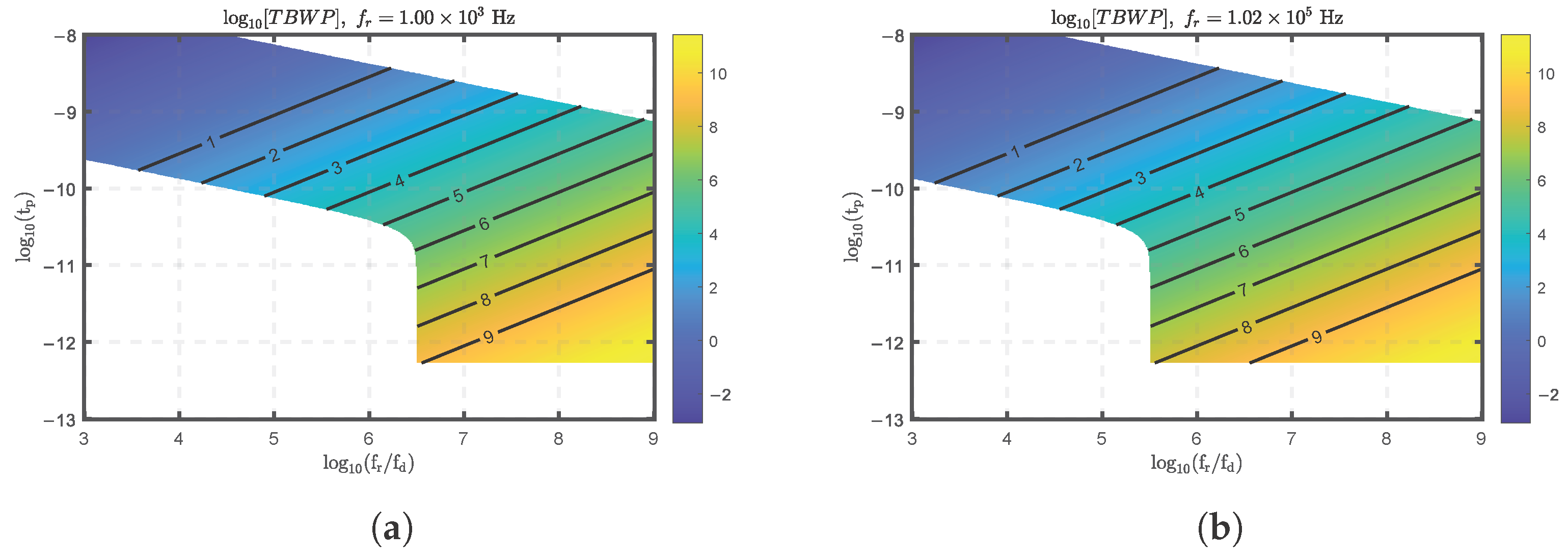
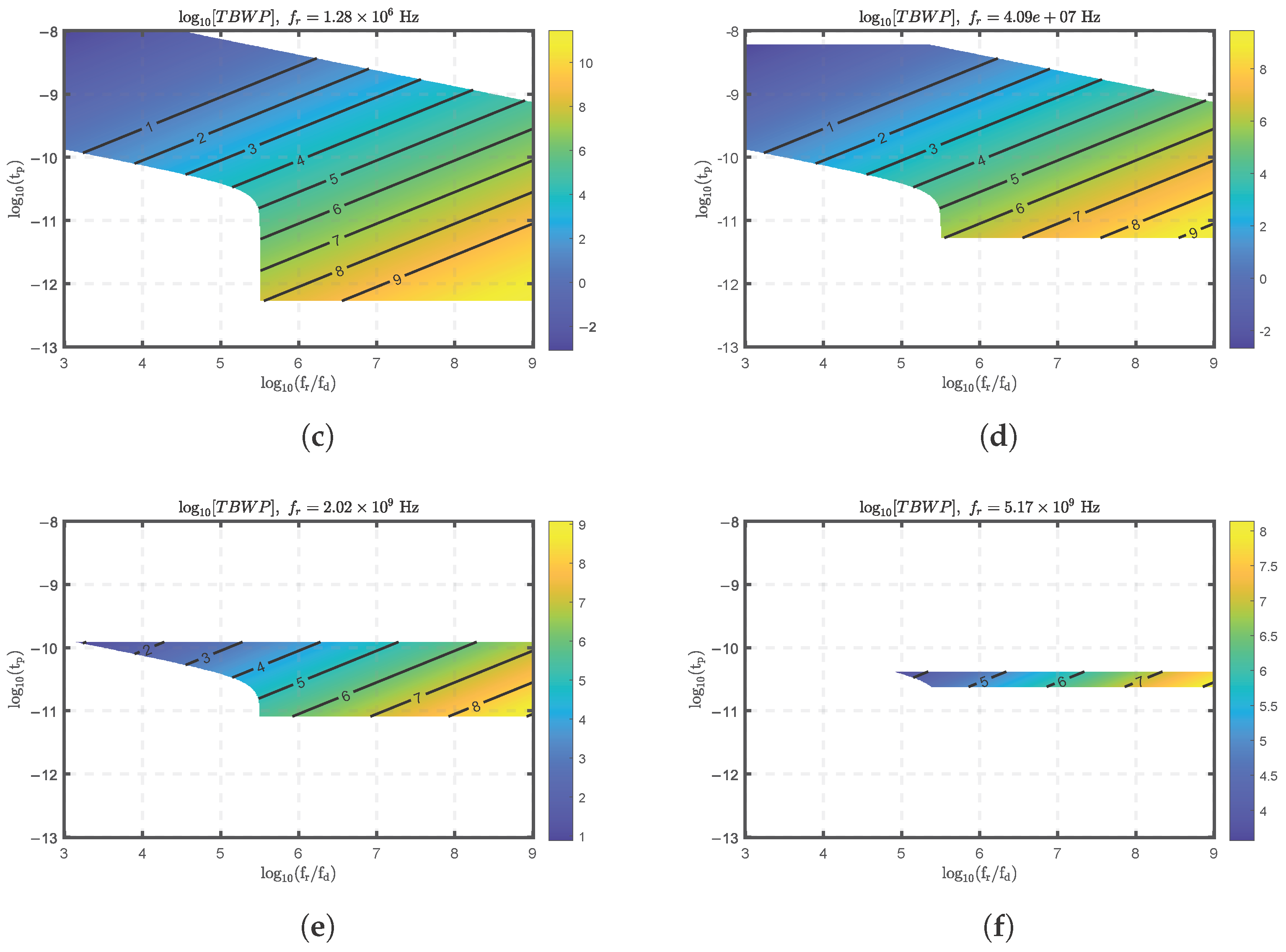


| Dual-Comb Parameters: = 44.1 MHz, = 228 Hz, = 1.934 | |||||
|---|---|---|---|---|---|
| Design Option | TBWP | Chirp Rate | |||
| ( = … ps, = … ps2) | (μs) | (GHz) | (GHz/μs) | (MHz) | |
| 1. (0.68, 500) | 284.44 | 234.05 | 1.65 | 37.32 | |
| 2. (10, 500) | 19.44 | 15.84 | 1.63 | 36.95 | |
| 3. (20, 2000) | 38.88 | 7.92 | 0.407 | 9.24 | |
| Ref. | Chirp Duration | Chirp Bandwidth | TBWP | Notes |
|---|---|---|---|---|
| [43] | 50 s | 11.52 GHz | Based on a recirculating frequency-shifting optical cavity | |
| [44] | 30 ms | 10 GHz | Microwave multiplication through sideband filtering of a dual-OFC | |
| [45] | 30 s | 50 GHz | Fourier-domain mode-locked chirped laser heterodyned with a CW laser | |
| [46] | 1 s | 20 GHz | Heterodyning of two integrated distributed Bragg reflector laser diodes | |
| This work | 284.44 s | 234.05 GHz | FTM of chirped Vernier dual-OFC pulse trains |
Disclaimer/Publisher’s Note: The statements, opinions and data contained in all publications are solely those of the individual author(s) and contributor(s) and not of MDPI and/or the editor(s). MDPI and/or the editor(s) disclaim responsibility for any injury to people or property resulting from any ideas, methods, instructions or products referred to in the content. |
© 2025 by the author. Licensee MDPI, Basel, Switzerland. This article is an open access article distributed under the terms and conditions of the Creative Commons Attribution (CC BY) license (https://creativecommons.org/licenses/by/4.0/).
Share and Cite
Alshaykh, M.S. Generating Large Time–Bandwidth Product RF-Chirped Waveforms Using Vernier Dual-Optical Frequency Combs. Photonics 2025, 12, 700. https://doi.org/10.3390/photonics12070700
Alshaykh MS. Generating Large Time–Bandwidth Product RF-Chirped Waveforms Using Vernier Dual-Optical Frequency Combs. Photonics. 2025; 12(7):700. https://doi.org/10.3390/photonics12070700
Chicago/Turabian StyleAlshaykh, Mohammed S. 2025. "Generating Large Time–Bandwidth Product RF-Chirped Waveforms Using Vernier Dual-Optical Frequency Combs" Photonics 12, no. 7: 700. https://doi.org/10.3390/photonics12070700
APA StyleAlshaykh, M. S. (2025). Generating Large Time–Bandwidth Product RF-Chirped Waveforms Using Vernier Dual-Optical Frequency Combs. Photonics, 12(7), 700. https://doi.org/10.3390/photonics12070700





